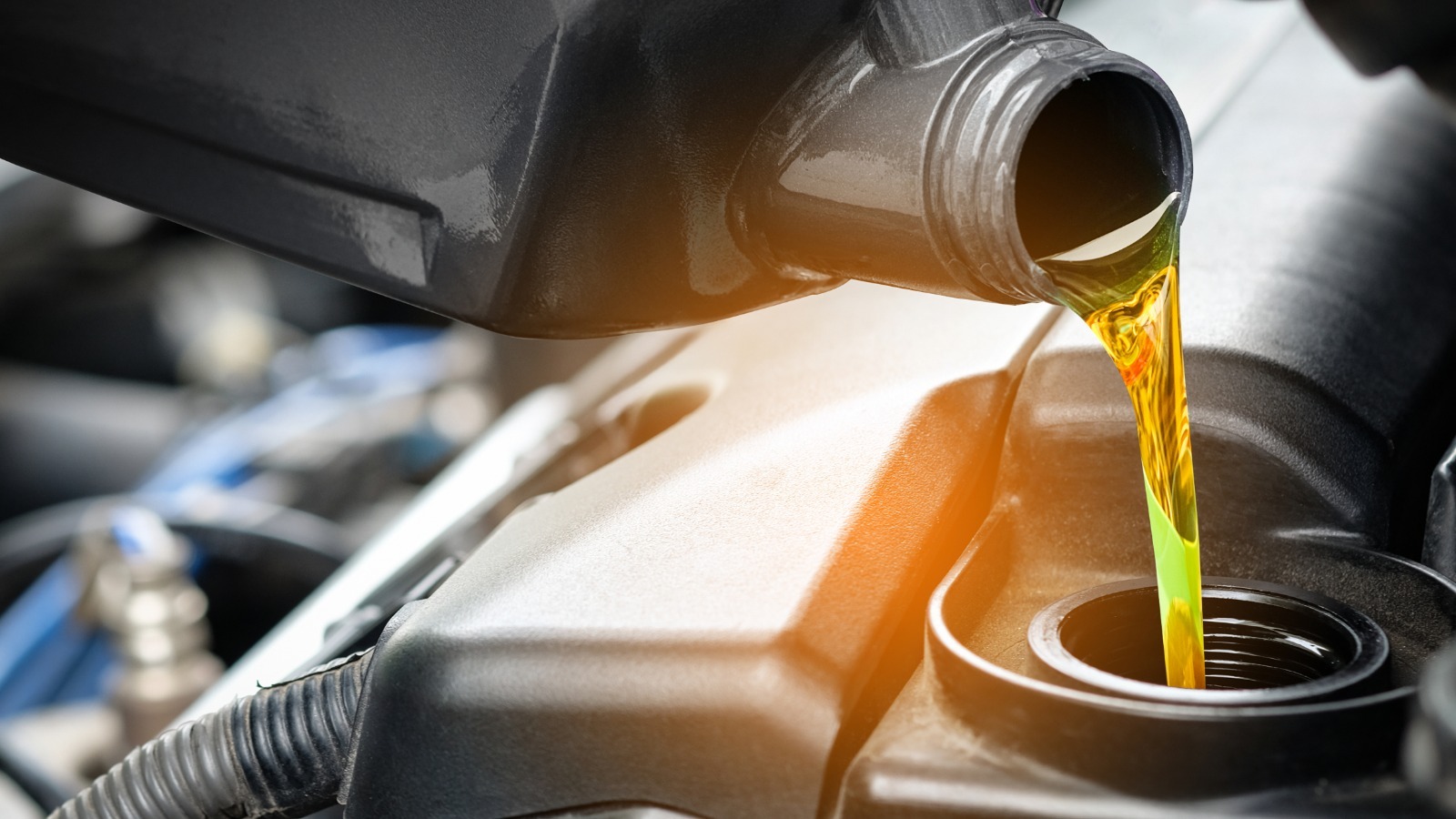
It's no secret that our vehicles require a massive number of parts to function. Whether you drive a car with a traditional internal combustion engine or a modern electric vehicle, at least one thing remains the same: the reliance on thousands of interworking parts and, yes, various fluids. You're probably familiar with at least some of the fluids your car needs, like motor oil and brake fluid , and you may have even heard the age-old joke about the fictional blinker fluid.
However, our vehicles use a lot more than just oil and brake fluid. In reality, nearly every one of your car's systems relies on a fluid of some type. Whether it's for lubrication, cooling, or a little of both, these liquids are essential for your vehicle's smooth operation .
If you're curious about the most important fluids that your car uses, stick around. As a former professional auto repair technician and a lifelong gearhead, I'll break it down for you in simple terms. We won't cover the extremely obvious fluids, like gasoline or diesel, or those that your vehicle doesn't technically need, like windshield washer fluid.
That said, we will go over six of the most vital fluids that most cars do need. Keep in mind that not every vehicle will use every fluid on this list — for example, EVs don't use engine oil, but they can use coolant and, sometimes, transmission fluid. I'll explain why your car needs these fluids, how they work, how often you need to check them, whether or not you can service them yourself, and which vehicles use each.
Let's dive in and check it out. One of the most critical fluids that nearly every internal combustion engine (ICE) vehicle needs is engine oil . This liquid is designed primarily to provide lubrication to your engine's internal moving parts.
Things like the crankshaft and camshaft(s) , pistons, and main bearings are all subject to constant friction when your car is turned on. That friction can prevent these parts from moving smoothly and generate extreme amounts of heat. Motor oil's principal responsibility is to prevent friction by providing lubrication to those internal components.
However, that's not all it does. Engine oil's secondary function is as a heat sink. As the oil travels through your engine, it absorbs heat.
The oil carries that heat away from the engine as it continues its journey back to the oil pan, where excess heat is able to dissipate. When it comes to servicing your engine oil , it's something that you need to do pretty regularly. In fact, checking your oil is one of the things you should be doing to your car every 1,000 to 3,000 miles .
You don't have to check the oil daily, but you should inspect its level and condition at least once or twice a month or before any road trips . It's simple to do and only involves popping the hood, pulling out your engine oil dipstick, and checking to confirm that the level is within the appropriate range. You should also make sure that the oil is in good condition, meaning that it's not extremely black, milky, or chunky.
If you don't know how to locate or read your engine oil dipstick, you should consult your vehicle owner's manual. The good news is that checking and even replacing engine oil is fairly easy — in fact, it's one of the best DIY auto projects for beginners . Brake fluid is another vital type of automotive fluid that basically every car uses, even electric vehicles .
It's a type of hydraulic fluid, and most automotive versions are made of glycol, a mixture of alcohol and glycerin. Brake fluid is used to create the hydraulic pressure necessary to actuate your car's brake system. While most cars use either disc or drum brakes , both types require brake fluid.
In each system, the hydraulic fluid creates pressure that pushes brake pads or shoes into a metal rotor or drum. When those components come into contact with each other, they create the friction that helps slow your car down. Electric vehicles, on the other hand, rely primarily on regenerative braking systems , meaning the electric motor uses the car's kinetic energy to stop it.
However, even EVs use standard brake systems as backups, which means you still have to service the fluid. Automotive brake systems are closed, meaning you shouldn't add fluid or lose fluid under normal circumstances. However, things rarely work exactly the way they're supposed to, and your fluid can become contaminated by water, air, or other particles over time.
Additionally, your brake fluid can leak, causing the level to become dangerously low — and because brake fluid is usually clear, you might not notice puddles on the ground. While you should replace your brake fluid roughly every couple of years or every 30,000 to 45,000 miles, you should be inspecting it much more frequently. Ideally, you should check your brake fluid every time you change your oil — roughly every 3,000 to 7,000 miles — and before any big trips.
Doing so is easy — simply confirm that the level is above the minimum line and that the fluid is relatively clear and free from major debris. Transmission fluid is another automotive fluid that essentially every car uses, including electric vehicles. While traditional transmission fluids are petroleum-based, synthetic varieties are made of various base oils and other additives.
Like engine oil, transmission fluid lubricates internal moving parts — just in the gearbox instead of the engine . Transmission fluid also helps dissipate heat by carrying it away from the sensitive gears, clutches, and other components inside the transmission. But while transmission fluid and engine oil share many characteristics and functions, they're not the same thing .
Fortunately, it's relatively easy to tell the difference: engine oil is usually an amber color when clean , while fresh transmission fluid is bright red. It can be more difficult to tell the difference between the two if they're dirty, and many people make the mistake of removing the transmission drain plug when performing oil changes. So, it's a good idea to always reference your owner's manual or repair guide when performing DIY work to avoid issues.
You should check your transmission fluid every time you replace the oil, but depending on your car, doing so is either relatively simple or a real pain. Many vehicles have transmission fluid dipsticks in the engine bay. They're usually located farther back in the bay but function similarly to the oil dipstick.
To check the fluid, leave your engine running and use the dipstick in the same way you would use the oil dipstick. However, some vehicles have sealed transmissions. These gearboxes don't have dipsticks, and you have to check the level and add fluid from beneath the car.
If you're not an experienced DIYer or home mechanic, you should probably leave your sealed transmission to a pro. However, you can check the level by removing the inspection/fill plug and visually inspecting the fluid. Like most of the other automotive fluids covered here so far, coolant is something that virtually every car uses, even many electric vehicles .
Its job is to travel through channels built-into the engine, absorbing heat and carrying it away from the motor's sensitive components. Coolant, which is actually a mixture of antifreeze and water , is part of a complex cooling system designed to prevent severe engine damage caused by excess heat. It comes in various colors , and it's important that you fill your car's radiator with the proper type.
Servicing your vehicle's cooling system involves flushing it out and replacing the old liquid with a fresh, clean version. While that's something you need to do roughly every 30,000 miles or every couple of years, you should check the coolant much more regularly. Like basically every other fluid on this list, coolant is absolutely essential for your vehicle's smooth performance and a long, healthy engine life .
That means that you should monitor its condition and level frequently. It's a good idea to check the coolant level each time you replace the oil. However, it doesn't hurt to inspect it more routinely, especially if you plan to take a long road trip, or you live somewhere with extremely hot temperatures.
It's easy to do, and you only have to confirm that the fluid level inside the coolant reservoir is within the appropriate range. Besides that, simply make sure that the liquid isn't extremely dirty or chunky. Basically anyone is capable of checking their coolant level, and doing so regularly can help you avoid some pretty severe engine overheating issues and the damage that comes along with them.
Not every car uses power steering fluid. If your vehicle has an electric power steering system, then you don't have to worry about this part. However, for the many modern cars that do still rely on power steering fluid, it's a vital liquid and all but essential for your vehicle's smooth operation and handling .
That's because, like brake fluid, power steering fluid is a type of hydraulic fluid used to create pressure. Your car's power steering system then uses that pressurized fluid to help you move the steering wheel, drastically reducing the effort necessary to direct your vehicle. Power steering fluid is usually red , much like transmission fluid — sometimes, the two fluids can be interchangeable, but that depends on your vehicle, and you should never just assume that you can use one or the other for both the gearbox and steering system.
When it comes to flushing the power steering system , it's something that you should do roughly every 40,000 to 80,000 miles, depending on your vehicle, or if you experience any signs of power steering trouble . Checking the power steering fluid, on the other hand, is something you should do more frequently. You've probably realized by now that these automotive fluids are very important, meaning it's critical that you check them regularly.
Like most of the others on this list, you should check your power steering fluid at least every time you replace the oil. And, again, it never hurts to do so more often. When inspecting the fluid, you just need to confirm that the level is within the appropriate range, as indicated by the lines on the reservoir, and that it isn't chunky, extremely-brown, or black.
Ask any professional mechanic about their least favorite automotive fluid, and I bet most of them will give you the same answer: differential fluid or gear oil. It's incredibly thick, has a truly awful natural smell, and is virtually impossible to clean out of rags and clothing. However, differential fluid — also known as gear oil — is also extremely important for the vehicles that use it .
It's responsible for lubricating the gears inside your car's differential, the slightly round object toward the middle of many vehicles' front and rear axles. Differentials are highly-complex pieces of equipment that send engine power to both sides of your car and allow the wheels on either side to spin at different rates. They're composed of extremely-technical gear sets, and if you're not a trained professional, you should avoid performing deep differential maintenance or repairs.
That said, checking and replacing the differential fluid is usually pretty easy. Like sealed transmissions, many differentials have a drain port and fill/inspection port. To check the fluid, all you have to do is open the fill/inspection port.
If oil comes pouring out, the differential is too full, and you should let it drain until fluid stops coming out. If no oil is visible, stick your pinky finger about an inch into the hole — if there's oil on your finger when you remove it, the level is okay. However, if there's no oil on your finger, you'll need to add more using the same hole.
Draining the differential either requires you to remove the drain plug, just like you'd do during an oil change, or, if your differential doesn't have a drain plug, you have to remove the cover..














